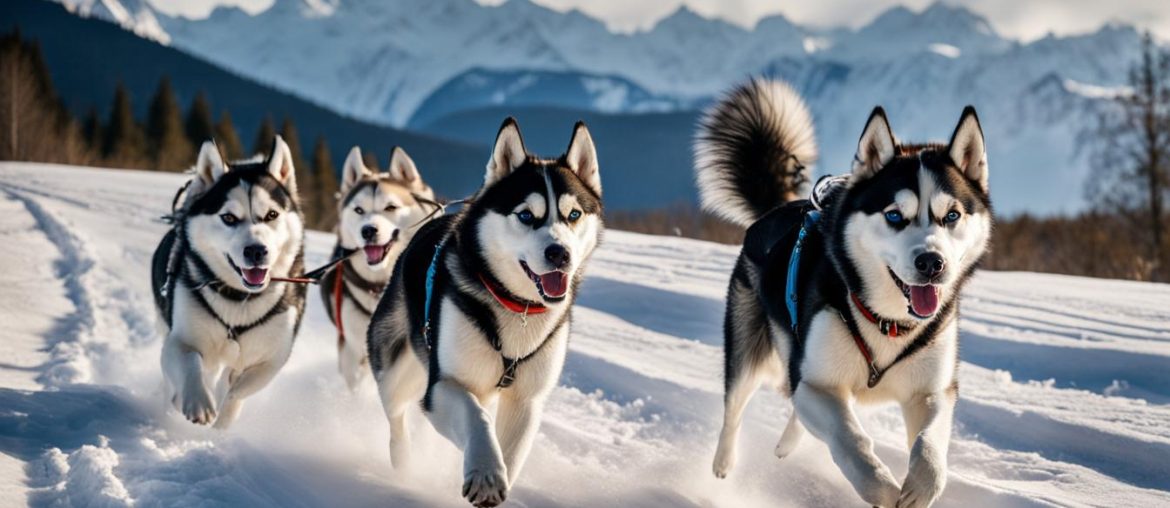Siberian Huskies are a popular breed known for their unique appearance and energetic personalities. If you’re considering adding a Siberian Husky to your family, you may be wondering about their lifespan and what factors can affect it. In this article, I will provide you with important information about the average lifespan of Siberian Huskies and key facts about their breed.
Key Takeaways:
- The average lifespan of a Siberian Husky is 12 to 14 years.
- Siberian Huskies are prone to certain health issues, including cataracts, progressive retinal atrophy, corneal dystrophy, hypothyroidism, and hip dysplasia.
- Proper nutrition and regular exercise are essential for their overall well-being.
- Siberian Huskies require ample space to roam and mental stimulation to prevent boredom.
- Early training and socialization are crucial for their development.
Now, let’s delve deeper into the lifespan of Siberian Huskies and explore the factors that can influence their health and well-being.
Caring for a Siberian Husky

Siberian Huskies are energetic and independent dogs that require proper care to thrive. Here are some important tips on how to take care of a Siberian Husky:
1. Provide ample space and mental stimulation
Siberian Huskies are active and intelligent dogs that need plenty of space to roam and mental stimulation to prevent boredom. They thrive in homes with active families and children. Engage them in activities such as long walks, hikes, and interactive games to keep them mentally and physically stimulated.
2. Ensure regular training and socialization
Training and socialization are crucial for Siberian Huskies from a young age. These dogs can be strong-willed and independent, so early and consistent training is necessary to correct any unwanted behaviors. Socialize them with other dogs, people, and different environments to ensure they grow up to be well-adjusted and friendly adults.
3. Feed a balanced diet and prevent overeating
Proper nutrition is essential for the overall health and well-being of Siberian Huskies. Feed them a high-quality dog food approved by the Association of American Feed Control Officials (AAFCO). Divide their meals into small portions throughout the day to prevent overeating. Avoid free-feeding as Huskies can easily overindulge and become overweight.
| Grooming Needs | Frequency |
|---|---|
| Brushing | Weekly |
| Bathing | As needed |
| Nail trimming | Monthly |
| Ear cleaning | Weekly |
“Siberian Huskies require ample space to roam and mental stimulation to prevent boredom.”
By following these tips, you can ensure that your Siberian Husky remains happy, healthy, and well-behaved. Remember to provide them with plenty of exercise, mental stimulation, and a balanced diet to meet their specific needs.
Siberian Husky Health Issues
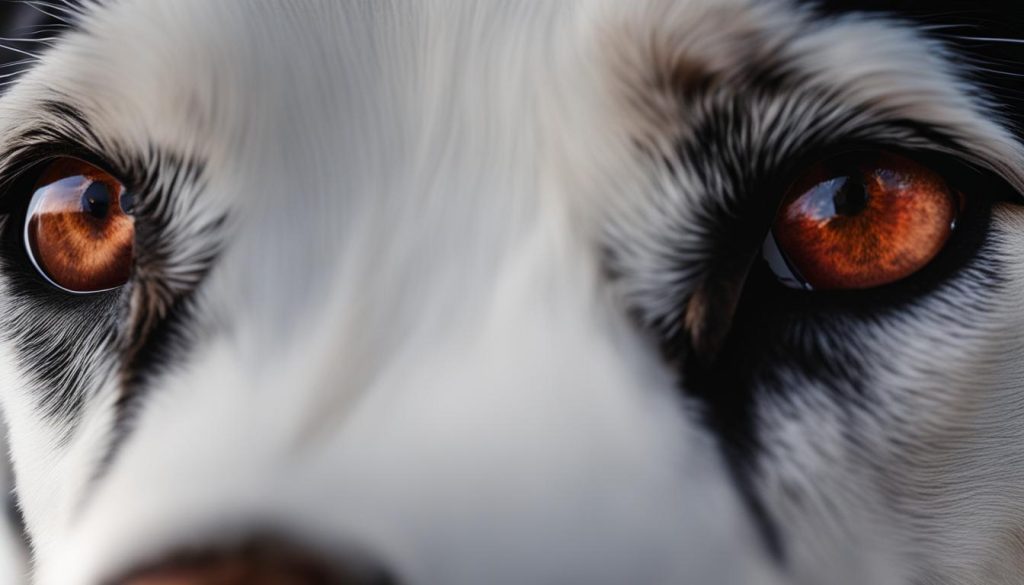
Siberian Huskies, like any breed, are prone to certain health issues that potential owners should be aware of. Understanding these common health conditions can help pet parents provide the necessary care and attention. Here are some of the health problems that Siberian Huskies may encounter:
1. Cataracts
Cataracts are a common health issue in Siberian Huskies. This hereditary condition causes clouding of the lens in the eye, leading to impaired vision. In severe cases, cataracts may require surgical intervention to restore eyesight.
2. Progressive Retinal Atrophy (PRA)
Progressive Retinal Atrophy is another genetic disease that affects Huskies. It gradually causes the degeneration of the retina, leading to progressive vision loss, particularly in low-light conditions or at night.
3. Corneal Dystrophy
Corneal dystrophy is characterized by the formation of opaque areas in the cornea of the eye. This condition can interfere with a Husky’s vision and may require treatment to preserve eyesight.
4. Hypothyroidism
Hypothyroidism is a condition where the thyroid gland does not produce enough hormones. In Huskies, it can lead to weight gain, hair loss, lethargy, and other symptoms. Regular monitoring and medical management are necessary to maintain a healthy thyroid function.
5. Hip Dysplasia
Hip dysplasia is a common orthopedic condition in Siberian Huskies. It occurs when the hip joint doesn’t develop properly, leading to discomfort, pain, and reduced mobility. Proper nutrition, exercise, and weight management can help alleviate symptoms and improve the quality of life for affected Huskies.
While these health issues are commonly seen in Siberian Huskies, not all Huskies will develop these conditions. Regular veterinary check-ups, a balanced diet, and a healthy lifestyle can go a long way in promoting the overall well-being and longevity of your beloved Husky.
What To Feed a Siberian Husky
Proper nutrition is essential for the health and well-being of a Siberian Husky. Feeding them a balanced diet is important in supporting their energy levels and maintaining their overall health. When deciding what to feed a Siberian Husky, it’s crucial to choose a high-quality dog food that is specifically formulated for their nutritional needs.
Nutrition for Siberian Huskies:
- A balanced diet should consist of high-quality protein sources such as chicken, turkey, or fish.
- Avoid dog foods that contain excessive fillers and artificial additives.
- Ensure the food is formulated to meet the nutritional standards set by the Association of American Feed Control Officials (AAFCO).
- Consider a diet with moderate fat content to support their active lifestyle.
- Include a variety of fruits and vegetables to provide essential vitamins and minerals.
- Consult with a veterinarian to determine the appropriate portion size and feeding frequency for your Siberian Husky.
Husky Dog Food Options:
There are various commercial dog food brands available that offer specific formulas for Huskies. Some popular options include:
“Brand A offers a grain-free formula that is rich in protein and supports healthy muscle development. Their ingredients include real meat, fruits, vegetables, and essential nutrients. This brand is known for its commitment to quality and nutrition.”
“Brand B provides a formula tailored to the unique needs of Siberian Huskies. Their blend incorporates a balance of proteins, carbohydrates, and healthy fats that promote optimal energy levels and a healthy coat. This brand is highly recommended by experts in the field.”
Remember, it’s important to consult with a veterinarian before making any changes to your Siberian Husky’s diet. They can provide personalized recommendations based on your dog’s specific needs and health conditions.
| Brand Name | Features |
|---|---|
| Brand A | – Grain-free formula – Rich in protein – Contains real meat, fruits, and vegetables – High quality and nutrition |
| Brand B | – Tailored formula for Huskies – Balanced proteins, carbohydrates, and healthy fats – Promotes energy and healthy coat – Recommended by experts |
Behavior and Training Tips for Siberian Huskies
Siberian Huskies have a unique temperament that requires special attention when it comes to their behavior and training. Understanding their traits and implementing effective training strategies can help you build a strong bond with your Husky and ensure their well-being.
Siberian Husky Temperament
Huskies are known for their friendly and outgoing nature, but they can also be independent and strong-willed. They have a high prey drive and may exhibit behaviors such as digging, chewing, or howling if not properly stimulated. It’s important to provide them with plenty of mental and physical exercise to prevent boredom and destructive behavior.
Training a Husky Dog
Training a Siberian Husky requires patience, consistency, and positive reinforcement. They respond well to rewards-based training methods that involve treats, praise, and play. Keep training sessions short and engaging, focusing on teaching them basic commands like sit, stay, and come. Socialization from an early age is crucial to help them become well-adjusted in various environments and around other animals and people.
“Training a Husky requires patience, consistency, and positive reinforcement.”
Husky Dog Behavior
Huskies are known for their pack mentality and may exhibit behaviors such as pulling on the leash or trying to assert dominance. It’s important to establish yourself as the pack leader through consistent training and clear boundaries. Using positive reinforcement techniques and providing them with ample exercise and mental stimulation can help curb any unwanted behaviors.
| Behavior and Training Tips for Siberian Huskies |
|---|
| Understand the unique temperament of Huskies |
| Implement positive reinforcement training methods |
| Socialize your Husky from an early age |
| Provide adequate mental and physical exercise |
| Establish yourself as the pack leader |
By understanding the behavior and training needs of Siberian Huskies, you can create a harmonious and fulfilling relationship with your furry companion. Remember to be patient, consistent, and provide them with the mental and physical stimulation they need to thrive.
Fun Activities for Siberian Huskies
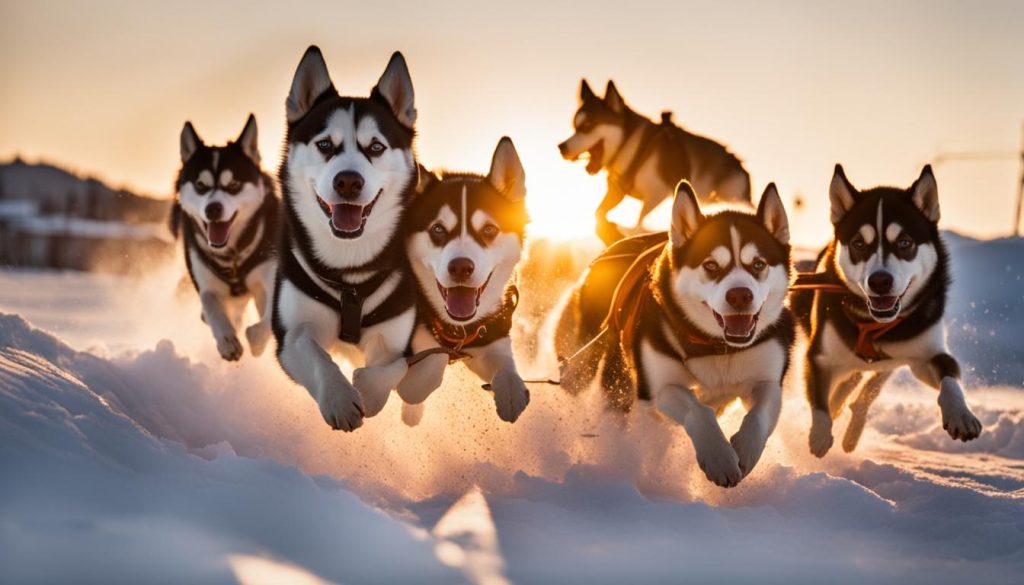
Siberian Huskies are energetic and playful dogs that thrive on physical activity and mental stimulation. To keep your Husky entertained and prevent boredom, it’s important to incorporate fun and engaging activities into their daily routine. Whether it’s outdoor adventures or interactive games, here are some exciting activities that will keep your Siberian Husky happy and entertained.
Outdoor Adventures
Siberian Huskies love outdoor activities and excel in tasks that allow them to utilize their natural instincts. Consider taking your Husky on hikes or long walks in nature trails where they can explore and experience different scents and environments. Joining them in activities like running or biking can also provide excellent exercise for your Husky while allowing them to expend their energy. Just make sure to observe your Husky’s behavior and adjust the intensity and duration of the activity based on their fitness level and the weather conditions. Remember to always keep your Husky on a leash to ensure their safety.
Interactive Games
Siberian Huskies are intelligent dogs that thrive on mental stimulation. Engaging them in interactive games helps keep their minds sharp and prevents boredom. Puzzle toys are an excellent way to challenge their problem-solving skills and reward them for their efforts. Hide treats or toys around the house or in the backyard and encourage your Husky to use their sense of smell to find them. You can also try playing hide and seek with your Husky, where you hide and call them to search for you. This game not only provides mental stimulation but also strengthens the bond between you and your furry friend.
Agility Training and Dog Sports
Siberian Huskies are known for their agility and athleticism. Participating in agility training or other dog sports can be a great way to channel their energy and stimulate their minds. Agility courses consist of various obstacles, such as tunnels, jumps, and weave poles, which your Husky can navigate under your guidance. This activity not only provides physical exercise but also improves their coordination and obedience. Additionally, you can explore other dog sports like obedience training, flyball, or dock diving, depending on your Husky’s interests and abilities.
Remember to always prioritize your Husky’s safety and well-being when engaging in any activity. Be mindful of their physical limitations, provide plenty of water and rest breaks, and avoid excessive exercise in extreme weather conditions. By incorporating these fun activities into your Husky’s routine, you’ll not only keep them entertained but also promote their overall physical and mental health.
Siberian Husky Grooming Guide

Grooming plays a crucial role in the overall well-being of a Siberian Husky. Their thick double coat requires regular attention to keep it clean and healthy. Here are some essential grooming tips for Husky dog owners:
Coat Care
The Husky’s coat consists of a dense undercoat and a longer topcoat, which helps protect them from extreme weather conditions. Regular brushing is necessary to remove loose hair and prevent matting. A rake-style brush or a slicker brush can effectively remove the undercoat. Brushing should be done at least once a week, and during shedding seasons, daily brushing will help manage their heavy shedding. Pay special attention to their hindquarters, as they tend to accumulate more dirt and debris in that area.
Bathing a Siberian Husky should only be done when necessary, as excessive bathing can strip the coat of its natural oils. Use a dog-specific shampoo and conditioner to keep their fur clean and healthy. When bathing, ensure thorough rinsing to prevent any residue from remaining on their skin, which can cause irritation.
Eye Care
Huskies are prone to certain eye conditions, and regular eye care is essential to keep their eyes healthy. Check their eyes regularly for any signs of redness, discharge, or irritation. Use a clean, damp cloth to gently wipe away any debris or dirt around their eyes. If you notice any persistent issues or changes in their vision, consult a veterinarian.
Ear Care
Husky owners should inspect their dog’s ears regularly for signs of infection or excessive wax build-up. Use a dog-specific ear cleaner and cotton balls or pads to clean the outer part of their ears. Avoid using cotton swabs or inserting anything deep into their ear canal, as it can cause injury. If you notice any foul odor, redness, swelling, or excessive scratching, seek veterinary attention.
Regular grooming and maintenance are crucial for keeping your Siberian Husky looking and feeling their best. By following these grooming tips and addressing any potential issues promptly, you can help ensure that your Husky remains healthy and happy.
Considerations for Husky Dog Owners
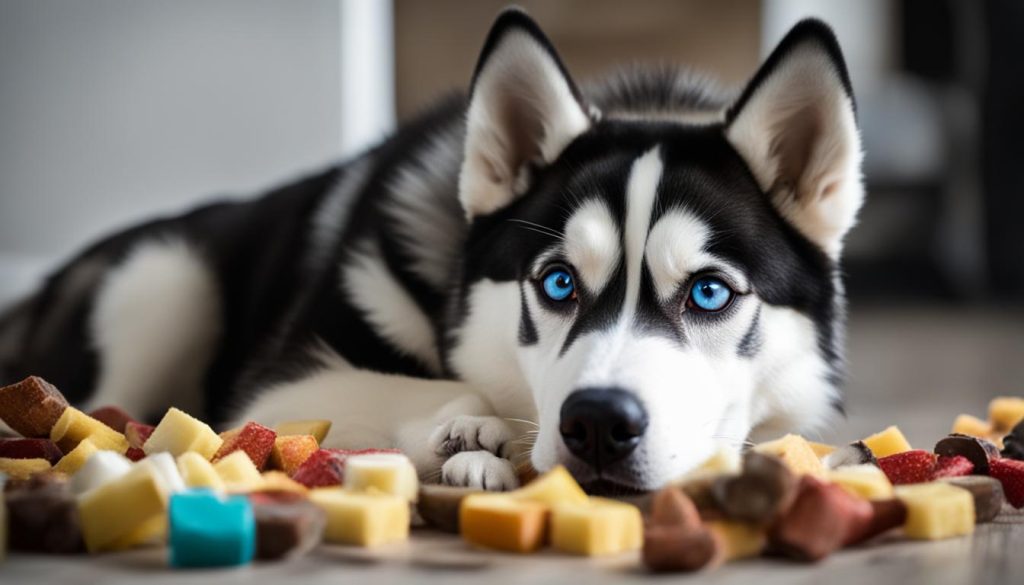
Owning a Siberian Husky can be a rewarding experience, but it’s important to consider a few key factors before bringing one into your home. Here are some things to keep in mind:
Grooming Needs:
Siberian Huskies have a thick double coat that requires regular grooming to keep it healthy and free of mats. They shed heavily twice a year, which means you’ll need to invest in a good brush and be prepared for some extra cleaning during those times. Additionally, Huskies have a tendency to “blow” their undercoat, meaning they will shed a significant amount of fur all at once. If you or a family member has allergies, a Husky may not be the best choice due to their shedding.
Exercise Requirements:
Huskies are a high-energy breed that thrives on regular exercise. They were bred to pull sleds for long distances, so they have a strong need for physical activity. Daily walks and playtime in a securely fenced yard are essential, but they may still require more exercise than the average dog. If you lead a sedentary lifestyle or don’t have the time or energy to provide ample exercise, a Husky may not be the right fit for you.
Training and Socialization:
Huskies are intelligent and independent dogs, which can make training a bit challenging. They have a strong prey drive and can be prone to roaming and chasing small animals if not properly trained and socialized. Early obedience training and consistent positive reinforcement are essential to ensure they grow up to be well-behaved and obedient pets. If you’re a first-time dog owner or don’t have the time to devote to training, a Husky may not be the best choice for you.
While Siberian Huskies are known for their stunning appearance and friendly nature, it’s important to carefully consider the responsibilities and requirements associated with owning one. By understanding their unique needs and providing them with the proper care, exercise, and training, you can ensure a fulfilling and rewarding relationship with your Husky.
What Makes a Siberian Husky Unique?
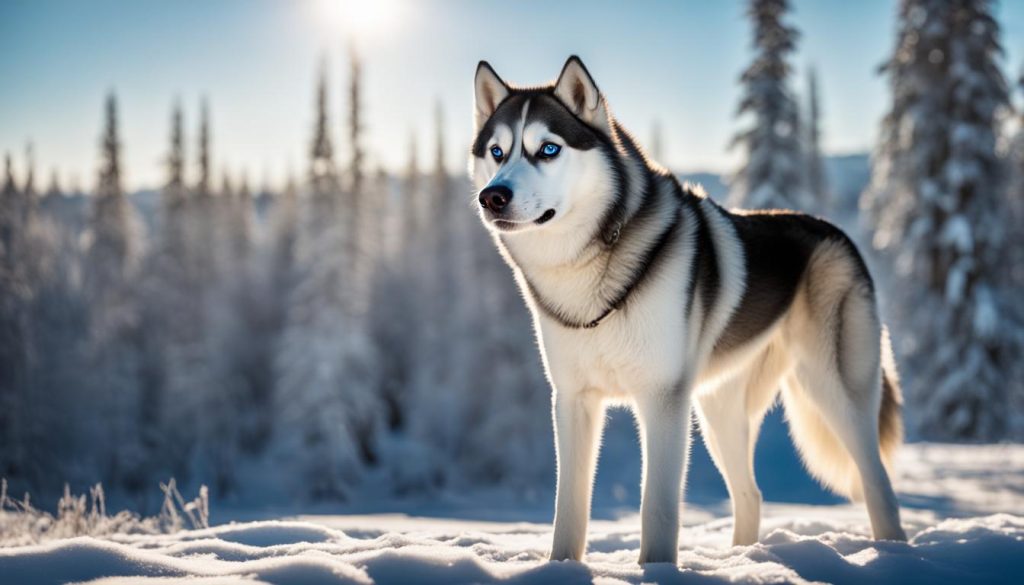
Siberian Huskies have several unique characteristics that set them apart from other breeds. One of the most striking features of Huskies is their stunning eyes. It’s not uncommon to see a Siberian Husky with heterochromia, a condition where each eye has a different color. This genetic trait adds to their distinctive appearance and captures the attention of everyone they meet. Their eyes can be blue, brown, green, or even a combination of colors, creating a mesmerizing gaze that is truly captivating.
Another special feature of Huskies is their thick double coat, designed to protect them in harsh weather conditions. This dense fur helps insulate them from the cold and keeps them comfortable in freezing temperatures. Their coats come in various colors and patterns, including black, gray, red, and white. Siberian Huskies require regular grooming to keep their coat healthy and prevent matting, but their stunning appearance is well worth the effort.
In addition to their physical characteristics, the history of Siberian Huskies adds to their uniqueness. Originating from the Chukchis of Northern Siberia, these dogs were bred for their strength, endurance, and ability to pull sleds over long distances. They played an integral role in the heroic serum run to Nome, Alaska, in 1925, where they transported life-saving medicine during a diphtheria epidemic. This historic event showcased the incredible loyalty and bravery of Siberian Huskies, earning them a special place in the hearts of dog lovers worldwide.
Siberian Husky Eye Colors
| Eye Color | Description |
|---|---|
| Blue | The most commonly seen eye color in Siberian Huskies. It can range from pale blue to vibrant blue. |
| Brown | Siberian Huskies with brown eyes often have a darker shade, resembling the color of chocolate. |
| Green | Rare but enchanting, green eyes give Siberian Huskies a unique and mesmerizing look. |
| Heterochromia | Some Siberian Huskies have one blue eye and one brown eye, creating a striking contrast that adds to their charm. |
“Siberian Huskies are not just dogs, but living works of art. Their unique eye colors and stunning appearance make them truly stand out among other breeds.”
The Legacy of Siberian Huskies
The story of Siberian Huskies is rich with courage and resilience. These dogs have served humanity for centuries, helping communities survive in the harshest of environments. From their origins with the Chukchis to their legendary involvement in the Nome serum run, they have proven themselves to be loyal, hardworking, and adaptable companions.
Today, Siberian Huskies continue to captivate people with their beauty and spirit. Their unique characteristics and fascinating history make them a breed like no other. Whether it’s their diverse eye colors, their striking appearance, or their remarkable heritage, Siberian Huskies truly stand out and leave a lasting impression on all who encounter them.
Wrapping Up
In conclusion, Siberian Huskies are a unique and fascinating breed of dog. With their energetic and friendly nature, they make wonderful companions for active families. However, it’s important to be aware of their potential health issues, such as cataracts, progressive retinal atrophy, corneal dystrophy, hypothyroidism, and hip dysplasia.
To provide the best care for your Siberian Husky, it’s crucial to prioritize proper nutrition, regular exercise, and regular vet check-ups. Training and socialization are also vital to ensure they become well-behaved dogs. Engaging them in various activities, such as hiking and dog sports, can help channel their energy and prevent destructive behavior.
Before bringing a Siberian Husky into your life, it’s important to consider the responsibilities and requirements associated with this unique breed. They require a lot of attention, exercise, and mental stimulation. If you’re ready for the challenge, a Siberian Husky can bring immense joy and companionship to your life.
FAQ
How long do Siberian Husky dogs live?
Siberian Huskies typically live between 12 to 14 years.
When were Siberian Huskies first introduced to the United States?
Siberian Huskies were first introduced to the United States in 1908.
What are the common health issues in Siberian Huskies?
Siberian Huskies are prone to health issues such as cataracts, progressive retinal atrophy, corneal dystrophy, hypothyroidism, and hip dysplasia.
What should I feed my Siberian Husky?
It is recommended to feed your Siberian Husky a high-quality dog food approved by the Association of American Feed Control Officials (AAFCO).
How should I train my Siberian Husky?
Early and consistent training, using positive reinforcement techniques, is essential for Siberian Huskies. Short, frequent training sessions with treats can be effective.
What activities are suitable for Siberian Huskies?
Siberian Huskies enjoy activities like hiking, running, and participating in dog sports such as agility and obedience training.
How should I groom my Siberian Husky?
Regular grooming, including brushing their double coat to remove loose hair, is necessary for Siberian Huskies. Bathing should only be done when necessary.
Are Siberian Huskies suitable for apartment living?
Due to their tendency to be vocal and howl, Siberian Huskies may not do well in apartments or close-knit neighborhoods.
What makes Siberian Huskies unique?
Siberian Huskies have distinctive features such as their ability to have heterochromia (two different colored eyes) and a rich history of being used by the Chukchis of Northern Siberia for transportation and hunting.
What should I consider before getting a Siberian Husky?
Potential owners should consider the breed’s exercise and mental stimulation needs, as well as the potential health issues associated with Siberian Huskies.


